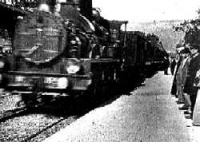Static camera
From The Art and Popular Culture Encyclopedia
(Difference between revisions)
| Revision as of 18:56, 3 April 2009 Jahsonic (Talk | contribs) ← Previous diff |
Current revision Jahsonic (Talk | contribs) |
||
| Line 1: | Line 1: | ||
| + | [[Image:Arrival of a Train at La Ciotat, 1895.jpg|thumb|right|200px|This page '''''{{PAGENAME}}''''' is part of the [[film]] series.<br>Illustration: screen shot from ''[[L'Arrivée d'un train en gare de La Ciotat]]'']] | ||
| {{Template}} | {{Template}} | ||
| - | Film frame]] | + | There was a time when all cameras were static, before the advent of the [[hand-held camera]]. A number of films have used a static camera: |
| + | |||
| + | *[[Empire State Building (film)]] | ||
| + | *[[Coming Apart (film)]] | ||
| + | *[[Jeanne Dielman, 23 quai du Commerce, 1080 Bruxelles]] | ||
| + | *[[Room 666]] | ||
| + | |||
| + | ==See also== | ||
| + | *[[Semiotics of the Kitchen]] | ||
| + | *[[Tracking shot]] | ||
| + | *[[Closed-circuit television]] | ||
| + | *[[Dutch angle]] | ||
| {{GFDL}} | {{GFDL}} | ||
Current revision

This page Static camera is part of the film series.
Illustration: screen shot from L'Arrivée d'un train en gare de La Ciotat
Illustration: screen shot from L'Arrivée d'un train en gare de La Ciotat
|
Related e |
|
Featured: |
There was a time when all cameras were static, before the advent of the hand-held camera. A number of films have used a static camera:
- Empire State Building (film)
- Coming Apart (film)
- Jeanne Dielman, 23 quai du Commerce, 1080 Bruxelles
- Room 666
[edit]
See also
Unless indicated otherwise, the text in this article is either based on Wikipedia article "Static camera" or another language Wikipedia page thereof used under the terms of the GNU Free Documentation License; or on research by Jahsonic and friends. See Art and Popular Culture's copyright notice.

